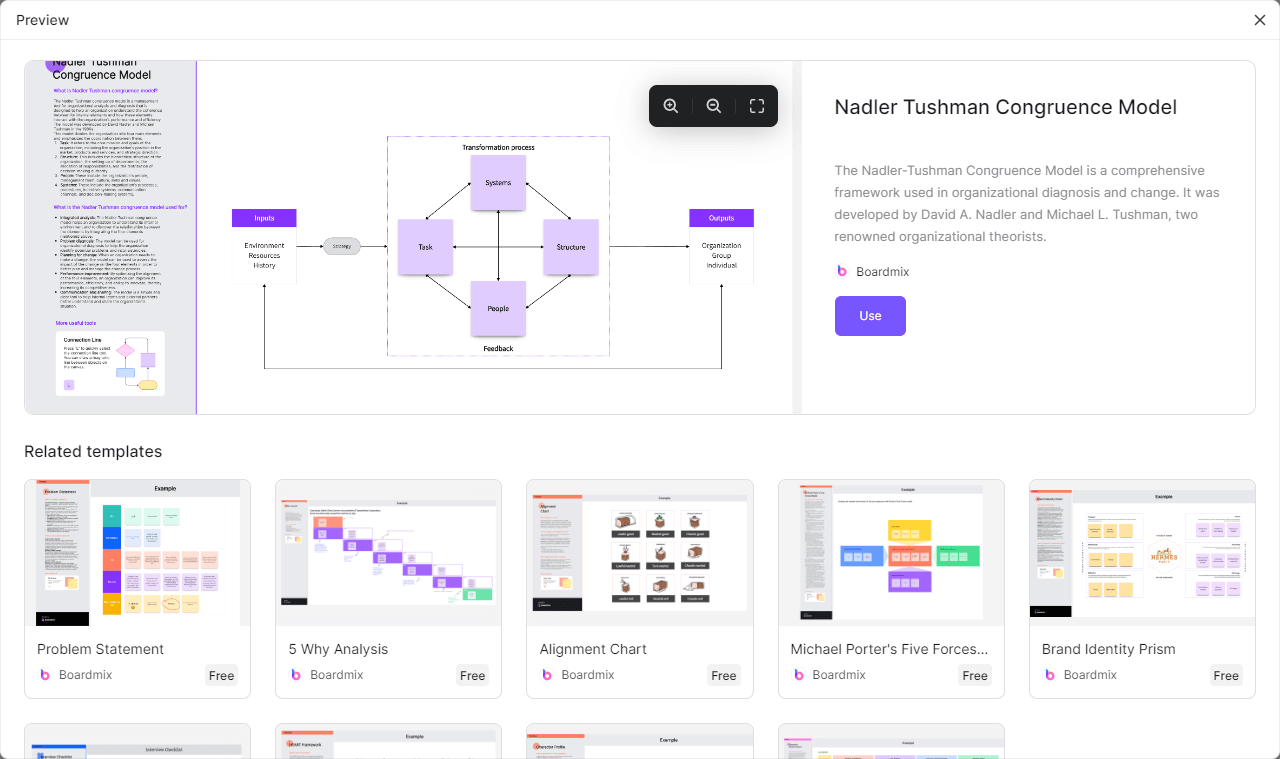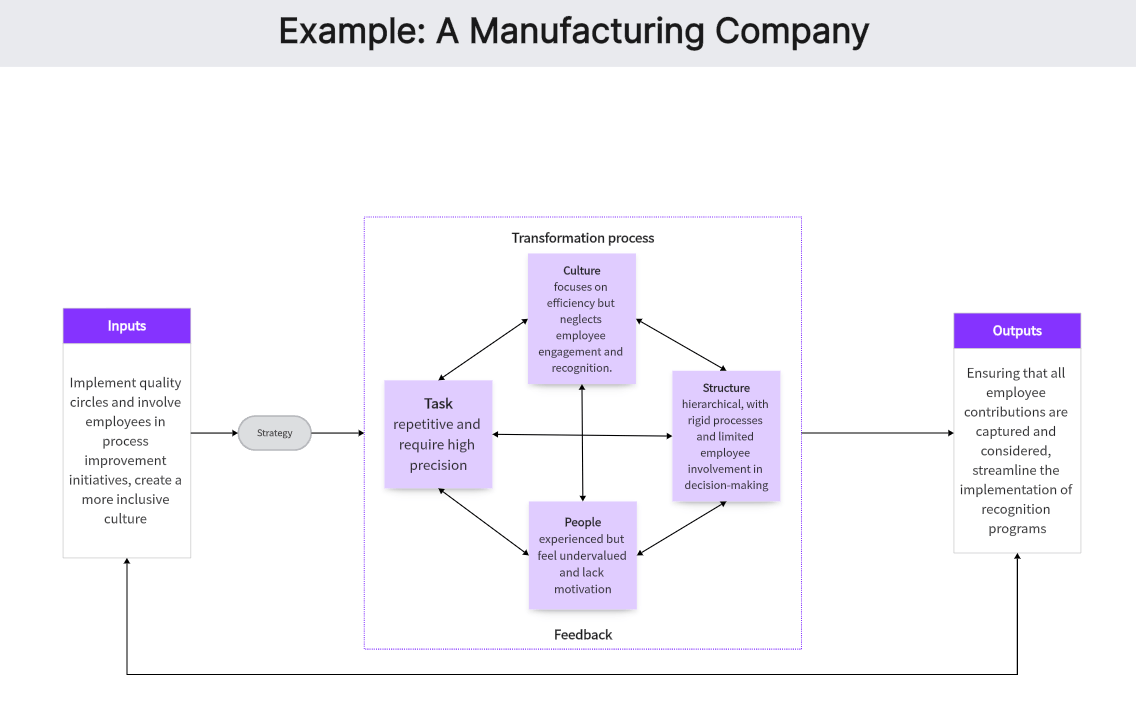Developed by David Nadler and Michael Tushman in the early 1980s, Nadler-Tushman Congruence Model emphasizes that the better these components fit together, the more effective and efficient the organization will be. This article explores the model's principles, pros and cons, practical applications, and how tools like Boardmix can facilitate its implementation, providing organizations with a streamlined approach to achieving optimal performance.
What is Nadler-Tushman Congruence Model?

The Nadler-Tushman Congruence Model, developed by David Nadler and Michael Tushman in the early 1980s, is a comprehensive diagnostic tool designed to help organizations improve performance by examining the fit between tasks, people, structure, and culture. The model posits that better alignment among these components leads to improved organizational performance, as their interactions within the context of the external environment determine overall effectiveness.
1. Tasks: The work that needs to be done to achieve organizational goals.
2. People: The individuals and groups performing the tasks, including their skills, needs, and attitudes.
3. Structure: The formal and informal systems, procedures, and relationships that organize how tasks are carried out.
4. Culture: The shared values, beliefs, and norms that influence how work gets done in the organization.
The model suggests that a high degree of fit between these components leads to improved organizational performance. Conversely, misalignment or incongruence among these components can result in inefficiencies, conflicts, and reduced performance. Therefore, diagnosing and improving congruence is critical for organizational success.
Nadler-Tushman Congruence Model Pros and Cons

Like any management model, the Nadler-Tushman Congruence Model has its advantages and disadvantages.
Pros:
- Holistic View: The model provides a comprehensive framework for analyzing an organization, considering multiple dimensions and their interdependencies.
- Diagnostic Tool: It helps identify misalignments and areas for improvement, making it a valuable tool for organizational development and change management.
- Flexibility: The model can be applied to various types of organizations and industries, making it versatile and widely applicable.
- Focus on Fit: Emphasizing the importance of alignment between different components, the model encourages a balanced approach to organizational design and change.
Cons:
- Complexity: The model's comprehensiveness can also be a drawback, as it may be challenging to analyze and address all components and their interactions.
- Resource Intensive: Implementing changes to achieve congruence can be time-consuming and require significant resources.
- Subjectivity: Assessing the degree of fit between components can be subjective and dependent on the perspectives of those conducting the analysis.
- Dynamic Environments: In rapidly changing environments, maintaining congruence can be difficult as the external and internal factors continuously evolve.
Using Boardmix can help mitigate some of these challenges by providing a streamlined, user-friendly platform for analysis and collaboration.
Boardmix’s interactive whiteboards and real-time collaboration features can simplify the complex processes involved in the Nadler-Tushman Congruence Model, making it easier for teams to diagnose and address misalignments.
How to Use the Nadler-Tushman Congruence Model?

Using the Nadler-Tushman Congruence Model involves several steps to diagnose and improve organizational performance. Here’s a step-by-step guide to applying the model effectively:
1. Define Organizational Goals: Start by clearly defining the organization's goals and objectives. Understanding what the organization aims to achieve provides a basis for evaluating the congruence of its components.
2. Analyze Components:
- Tasks: Identify the key tasks necessary to achieve organizational goals. Consider the complexity, variety, and interdependence of these tasks.
- People: Assess the skills, attitudes, and behaviors of individuals and groups within the organization. Determine if they are well-matched to the tasks they perform.
- Structure: Examine the formal and informal organizational structure. Consider hierarchies, communication channels, and decision-making processes.
- Culture: Evaluate the organizational culture, including shared values, beliefs, and norms. Consider how culture influences behavior and task performance.
3. Assess Fit: Evaluate the alignment between tasks, people, structure, and culture. Identify any areas of misalignment or incongruence that may hinder organizational performance.
4. Diagnose Problems: Based on the assessment, diagnose specific issues that arise from misalignment. Determine how these issues impact overall performance and identify their root causes.
5. Develop Solutions: Propose solutions to address the identified issues. This may involve changes to tasks, reassigning roles, restructuring the organization, or modifying cultural elements.
6. Implement Changes: Develop an implementation plan to make the necessary changes. Ensure that changes are communicated effectively and that stakeholders are engaged in the process.
7. Monitor and Adjust: Continuously monitor the impact of changes and make adjustments as needed. Ensure that the organization maintains congruence over time and adapts to any new challenges or changes in the environment.
Boardmix can significantly enhance each step of this process by providing tools and Nadler-Tushman Congruence Model templates that facilitate analysis and planning. With Boardmix’s pre-designed templates, you can easily map out the four components of the model and assess their alignment. The platform’s interactive whiteboard allows teams to collaborate in real-time, ensuring that all perspectives are considered and that the analysis is thorough and accurate.
Additionally, Boardmix’s customizable workspaces allow you to tailor the tool to your organization’s specific needs, making it easier to implement and monitor changes effectively.
Nadler-Tushman Congruence Model Examples
To better understand how the Nadler-Tushman Congruence Model can be applied, let’s explore a few examples:
Example 1: A Technology Startup

A technology startup aims to innovate rapidly and bring new products to market. However, the company faces challenges with project delays and employee burnout.
- Tasks: The tasks require high levels of creativity and technical expertise.
- People: Employees are highly skilled but often work in isolation and lack clear direction.
- Structure: The organizational structure is flat, with minimal formal processes and unclear decision-making authority.
- Culture: The culture emphasizes innovation but lacks support for collaboration and work-life balance.
Assessment: There is a misalignment between the need for collaboration (tasks) and the isolated working style (people). The flat structure contributes to unclear responsibilities, and the culture needs to better support work-life balance.
Solution: Introduce team-based projects to foster collaboration, clarify roles and responsibilities, and promote a culture that values work-life balance through flexible working arrangements and wellness programs.
Using Boardmix, the startup can create collaborative spaces where team members can work together on projects in real-time. The platform’s interactive whiteboards can be used to map out roles and responsibilities, ensuring clarity and alignment.
Additionally, Boardmix’s Nadler-Tushman Congruence Model templates can help structure the new processes and workflows, making the implementation of changes more straightforward and effective.
Example 2: A Manufacturing Company

A manufacturing company experiences quality control issues and declining employee morale.
- Tasks: Tasks are repetitive and require high precision.
- People: Employees are experienced but feel undervalued and lack motivation.
- Structure: The organizational structure is hierarchical, with rigid processes and limited employee involvement in decision-making.
- Culture: The culture focuses on efficiency but neglects employee engagement and recognition.
Assessment: There is a misalignment between the repetitive nature of tasks (tasks) and the lack of motivation among employees (people). The hierarchical structure limits employee involvement, and the culture does not support employee engagement.
Solution: Implement quality circles and involve employees in process improvement initiatives. Introduce recognition programs to boost morale and create a more inclusive culture that values employee contributions.
Boardmix can facilitate the implementation of these solutions by providing tools for real-time collaboration and feedback. The quality circles can use Boardmix’s interactive whiteboards to brainstorm and document process improvements, ensuring that all employee contributions are captured and considered.
The platform’s integration options can also help streamline the implementation of recognition programs, making it easier to track and acknowledge employee achievements.
Nadler-Tushman Congruence Model Tools and Templates
Utilizing tools and templates can streamline the application of the Nadler-Tushman Congruence Model. One such tool is Boardmix.
By leveraging Boardmix, organizations can simplify the application of the Nadler-Tushman Congruence Model, making it more accessible and effective. Boardmix enhances collaboration and efficiency, allowing teams to work together seamlessly and make data-driven decisions to foster a more harmonious and productive work environment.
Boardmix offers several features that make it an excellent choice for applying the Nadler-Tushman Congruence Model:
1. Interactive Whiteboard: Boardmix provides an interactive whiteboard where teams can collaboratively analyze and map out the four components of the model. This visual representation helps in identifying misalignments and developing solutions more effectively.
2. Templates: Boardmix offers pre-designed Nadler-Tushman Congruence Model templates, making it easier to structure the analysis. These templates guide users through the assessment process, ensuring all critical areas are covered.

3. Real-Time Collaboration: With Boardmix, multiple team members can work together in real-time, regardless of their location. This feature enhances communication and ensures that everyone’s input is considered during the analysis and solution development phases.
4. Integration and Export Options: Boardmix integrates with various tools and allows for easy export of the analysis and plans. This feature ensures that the work done on the platform can be seamlessly incorporated into broader project management and reporting systems.
5. Customizable Workspaces: Boardmix allows users to create and customize workspaces to fit the specific needs of their organization. This flexibility ensures that the tool can be tailored to support the unique aspects of the organization's analysis and planning processes.
Using Boardmix in conjunction with the Nadler-Tushman Congruence Model not only simplifies the process but also enhances the accuracy and effectiveness of the analysis. By leveraging Boardmix’s features, organizations can ensure that their diagnostic and improvement efforts are collaborative, comprehensive, and aligned with their overall goals.
Conclusion
The Nadler-Tushman Congruence Model helps diagnose and improve organizational performance by aligning tasks, people, structure, and culture. Tools like Boardmix enhance efficiency by offering interactive whiteboards, templates, real-time collaboration, and integration options.
Boardmix simplifies applying the Nadler-Tushman Congruence Model, making it accessible for organizations to identify and address misalignments. By streamlining processes and fostering collaboration, Boardmix helps organizations continuously adjust strategies for sustained success.













